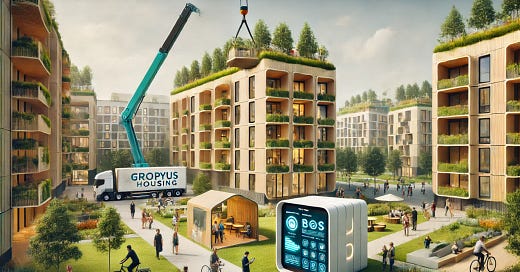GROPYUS: Designing Housing Like a Product, Operating It Like a Platform
How a Tech-Driven Construction Startup Is Reimagining Housing Through Smart Systems, Modular Design, and Sustainability at Scale
Hey Archinnovators,
Picture this - a multi‑story apartment building arriving on site almost fully assembled crafted with precision by robots, delivered timber‑hybrid, and topped off with a digital “Building Operating System.” Behind this vision is a deep desire: create sustainable homes with quality, speed, and affordability. This is the story of Gropyus,
a next‑generation construction‑tech firm reimagining how apartment buildings are designed, built, and managed. Let’s dive in.
1. Design Philosophy Meets Business Reality
GROPYUS envisions a world where sustainable living isn’t a luxury, it’s the default. Their approach begins with a provocative idea: what if homes were more like evolving products than static structures? That means treating buildings as living systems - designed with beauty, built with precision, and managed with intelligence. The result is a seamless fusion of sustainability, speed, and smart design. In this world, architectural excellence isn’t sacrificed for business efficiency, it’s enabled by it.
2. Core Innovation at a Glance
At its core, GROPYUS has fused product thinking, factory precision, and software intelligence into one integrated construction platform. Their buildings are made from prefabricated timber-hybrid modules, assembled by robots, and operated by a proprietary Building Operating System (BOS). Imagine a Tesla-like housing model: the home is the hardware, BOS is the software, and the resident experience is continuously upgraded. This digital layer ensures lower emissions, reduced maintenance, and smarter living.
3. Origin Story
GROPYUS was founded in 2019 by Markus Fuhrmann (Delivery Hero) and Philipp Erler (Zalando), both veterans of tech startups frustrated by how archaic the construction world remained. While other industries evolved with digital workflows and user-centered design, building still suffered delays, cost overruns, and climate harm. Their "aha" moment: apply tech-industry discipline to create sustainable, affordable housing using timber, automation, and software. That meant not just tweaking processes, but building a whole new ecosystem from scratch.
4. The Business Canvas, Simply Explained
Value Creation:
GROPYUS delivers energy-efficient, prefabricated homes embedded with digital systems. Their product improves urban housing - offering comfort, affordability, and sustainability in one.Revenue Streams:
Sale or lease of modular apartment buildings
Ongoing fees from the BOS platform (energy, maintenance, smart services)
Add-on service subscriptions from tenants (concierge, comfort settings, etc.)
Key Relationships:
Robotics partner KUKA, timber experts like CREE, city governments, and institutional funders (e.g., European Investment Bank) all contribute to their ecosystem.Resource Strategy:
GROPYUS operates an predominantly automated factory, uses renewable timber materials, and employs an in-house tech team to continually evolve the BOS platform.Client Approach:
Their focus is on fast-growing urban centers with severe housing shortages. They target developers and public-sector clients who value speed, ESG performance, and long-term operational efficiency.
5. Making It Work Day-to-Day
A GROPYUS project begins on a digital configurator, not a drafting table. Architects input constraints and preferences, then generate layouts compatible with robotic production. Within the factory, machines assemble floor and wall modules, cutting down build time from months to weeks. On site, installation resembles assembling IKEA furniture on a city scale. Post-occupancy, BOS kicks in: regulating energy use, triggering predictive maintenance, and offering resident services via a user app. Every building is a feedback loop of performance, constantly optimized in real time.
6. Trade-offs and Hard Choices
To achieve scalability, GROPYUS sacrifices full architectural freedom. Their modules dictate certain dimensions, systems, and finishes, limiting bespoke design. Yet this standardization fuels their speed and cost control. The model also demands massive up-front capital for factories and tech development. It’s a long game: profitability comes through volume and ecosystem integration, not one-off projects. Regulatory complexity across markets also requires persistent alignment work.
7. Signs of Success
GROPYUS has grown to over 300 employees across six locations, with a target of producing 3,500 apartments annually. Their method cuts construction time by about 50% and slashes carbon emissions by up to 90%. As a major vote of confidence, they are Financial backed by Venture Capital and European Investment Bank. Most importantly, their buildings prove that smart, sustainable design doesn’t need to be slow or expensive, it just needs a better system.
8. Lessons for Other Practices
Productize thoughtfully: Think of your design not as a one-off masterpiece, but as a repeatable system that delivers consistent quality.
Digitize your process: Use digital tools to bridge the gap between concept and construction, reducing errors and improving control.
Design for performance, not just appearance: Add value post-occupancy, through data, services, and energy efficiency, not just through form.
Accept creative constraints: Like site limitations or code requirements, modular systems can actually sharpen rather than limit creativity.
Collaborate like a tech company: Forge strong partnerships across disciplines, engineering, software, manufacturing to build a coherent whole.
GROPYUS isn’t just rethinking how buildings look, they’re reinventing how they’re made, lived in, and evolve over time. Their model blends the rigor of tech with the ethics of architecture. For architects, it’s a powerful reminder: when you design a better business model, you don’t limit your creativity, you unleash it.
GROPYUS proves that great architectural thinking and a bold business model can redefine building. By marrying industrial precision, digital intelligence, and timber-hybrid design, they’ve created sustainable housing at scale. Their story shows architects that entrepreneurship, tech, and design can form a coherent, creative whole and that strong business models engineer rather than constrain great architecture.




